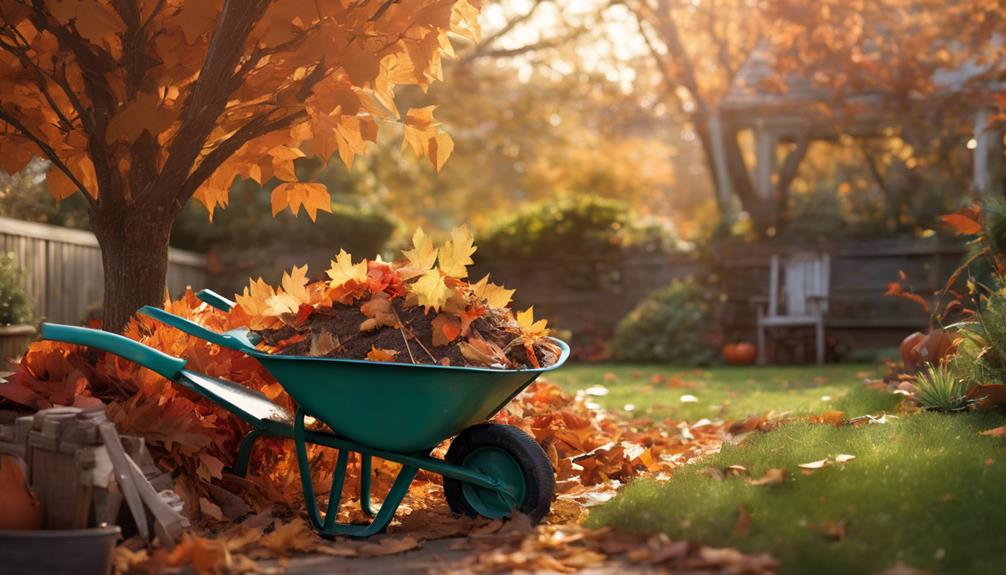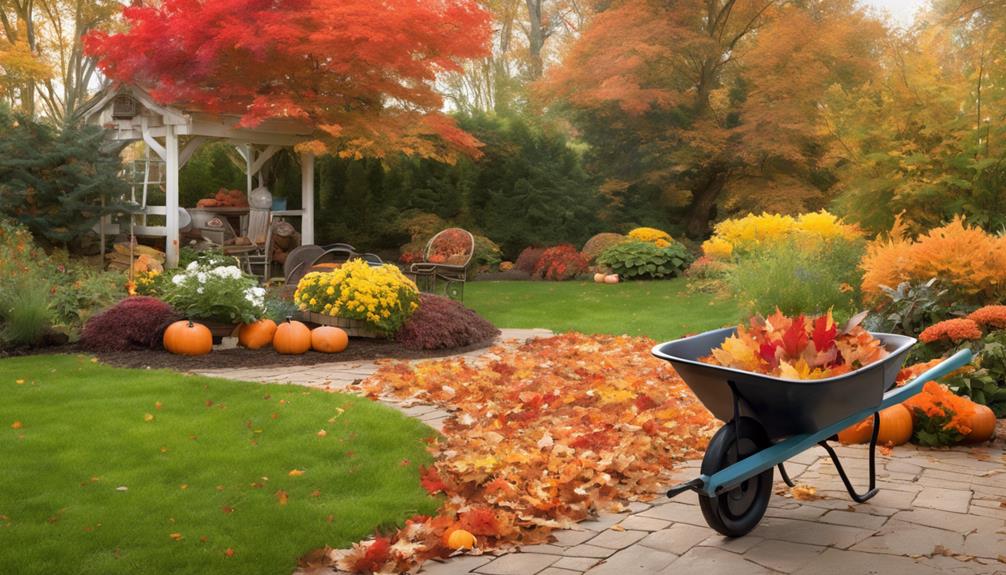
3 Best Benefits of Seasonal Garden Cleanup Services
14 October 2024
Top 10 Tips for Small Backyard Cleanup
15 October 2024Seasonal garden cleanup and maintenance encompasses vital tasks to prepare the garden for upcoming weather changes and promote plant vitality.
This process involves removing debris, improving soil quality through amendments, and ensuring proper drainage. It also requires evaluating and pruning plants for healthy growth, in addition to implementing pest control strategies to protect against infestations.
Furthermore, adjusting irrigation systems to cope with fluctuating moisture levels is essential. By prioritising these steps, gardeners can foster a thriving ecosystem that supports robust plant development.
Learning more about effective practices can greatly enhance the success of your gardening efforts.
Seasonal Garden Preparation Essentials
Effective seasonal garden preparation hinges on two critical components: soil preparation techniques and plant selection guidelines.
Properly amending and testing soil ensures that plants receive the necessary nutrients for optimal growth.
Furthermore, selecting the right plants for the season can greatly enhance the garden's overall health and aesthetic appeal.
Soil Preparation Techniques
Soil preparation serves as the foundation for a successful garden, playing an essential role in plant health and productivity.
To cultivate ideal soil conditions, begin by testing pH and nutrient levels, employing amendments such as lime for acidity adjustment or compost for nutrient enhancement.
The incorporation of organic matter is fundamental; it improves soil structure and boosts microbial activity.
Tilling should be undertaken judiciously to avoid soil compaction while maintaining moisture retention.
Moreover, implementing crop rotation and cover cropping can further enrich the soil and prevent nutrient depletion.
Finally, ensure proper drainage to mitigate waterlogging, which can inhibit root development.
Mastering these soil preparation techniques will greatly bolster your garden's potential for thriving plant growth.
Plant Selection Guidelines
When preparing for a seasonal garden, selecting the right plants is crucial to ensure a thriving and visually appealing landscape.
Begin by evaluating your local climate and soil conditions, as these factors dictate plant viability. Opt for native species that naturally adapt and flourish in your environment, ensuring resilience against pests and diseases.
Consider the garden's microclimates, noting sun and shade patterns, as well as moisture levels. Furthermore, prioritise plants with staggered bloom times to maintain visual interest throughout the season.
Ultimately, assess the mature size of each plant, allowing for proper spacing to avoid overcrowding. By adhering to these guidelines, you can create a cohesive and sustainable garden that enhances your outdoor space.
Soil Quality and Preparation
Soil quality is crucial to successful gardening, requiring careful preparation to ensure ideal plant growth.
Incorporating organic matter, implementing mulching techniques for moisture retention, and conducting soil pH testing are vital practices that enhance soil health.
Addressing these aspects will create a robust foundation for a thriving garden ecosystem.
Organic Matter Incorporation
Incorporating organic matter into your garden is essential for enhancing soil quality and preparing for the upcoming growing season. This practice not only improves soil structure but also increases nutrient availability and promotes beneficial microbial activity.
To effectively incorporate organic matter, consider the following steps:
- Select Quality Amendments: Use compost, well-rotted manure, or leaf mould for maximum benefits.
- Timing: Apply organic matter during autumn or early spring for ideal integration.
- Application Methods: Mix organic amendments into the top 15-30 centimetres of soil, ensuring even distribution.
- Monitor Soil Health: Regularly assess soil structure and fertility to adjust organic matter incorporation as needed.
Mulching for Moisture Retention
A thick layer of mulch can significantly enhance moisture retention in the garden, providing essential benefits for plant health and soil quality.
By minimising evaporation and regulating soil temperature, mulch creates an ideal environment for root development.
The following advantages underscore the importance of mulching:
- Water Conservation: Reduces the frequency of irrigation by retaining soil moisture.
- Weed Suppression: Limits weed growth, which competes for water and nutrients.
- Soil Temperature Regulation: Insulates the soil, maintaining a consistent temperature for plant roots.
- Organic Matter Supplementation: As mulch decomposes, it enriches the soil, enhancing its structure and fertility.
Incorporating a suitable type of mulch tailored to specific garden needs guarantees sustained moisture levels, promoting thriving plants.
Soil Ph Testing Importance
Understanding the pH level of garden soil is crucial for ensuring optimal plant health and productivity, as it directly influences nutrient availability and microbial activity.
Regular soil pH testing plays a vital role in effective garden management.
- Nutrient Availability: A balanced pH optimises the accessibility of essential nutrients to plants.
- Microbial Activity: Soil organisms thrive within specific pH ranges, promoting a healthy ecosystem.
- Plant Selection: Comprehending pH aids in selecting plants suited to your soil conditions.
- Amendment Strategies: Knowledge of pH informs necessary amendments, ensuring proper soil preparation.
Practical Garden Cleanup Steps
Effective garden cleanup begins with gathering the necessary tools to streamline the process.
Following this, proper sanitisation techniques for these tools are essential to maintaining plant health and preventing the spread of disease.
Furthermore, integrating vertical gardening innovations can improve space efficiency and enhance the overall aesthetics of the garden.
Gather Necessary Gardening Tools
Successful garden cleanup requires a well-organised toolkit to tackle diverse tasks efficiently.
Selecting the right tools not only streamlines the process but also ensures that you can address specific challenges that arise during seasonal maintenance.
Here are four crucial tools to include in your toolkit:
- Pruning Shears – For precise cuts on shrubs and perennials, promoting healthy growth.
- Garden Rake – Ideal for gathering leaves and debris, ensuring a tidy garden space.
- Trowel – Vital for planting, weeding, and transferring soil with accuracy.
- Garden Gloves – Protect your hands while providing a firm grip for all tasks.
Proper Tool Sanitization Techniques
Maintaining a clean and healthy garden starts with proper tool sanitisation, which is essential for preventing the spread of disease and pests.
Implementing effective sanitisation techniques ensures your gardening tools remain in peak condition and safeguard your plants.
- Clean Debris: Remove soil, sap, and plant material from tools using a wire brush or cloth.
- Wash with Soap: Use warm, soapy water to thoroughly wash tools, ensuring all surfaces are cleaned.
- Disinfect: Soak tools in a solution of 10% bleach or a commercial disinfectant for at least 10 minutes to eliminate pathogens.
- Dry and Store: Allow tools to air dry completely before storing them in a dry, protected area to prevent rust and further contamination.
Vertical Gardening Innovations
Vertical gardening has emerged as a revolutionary approach to maximising space and enhancing garden aesthetics, particularly in urban settings.
This creative technique not only improves air quality and provides food but also creates an inviting atmosphere.
To implement vertical gardening effectively, consider the following steps:
- Select Appropriate Structures: Utilise trellises, wall planters, or modular systems tailored to your space.
- Choose Suitable Plants: Opt for climbing varieties or compact plants that thrive in vertical arrangements.
- Implement Efficient Watering Systems: Consider drip irrigation or self-watering containers to ensure optimal moisture.
- Incorporate Soil Health Practices: Focus on quality soil and organic fertilisers to enhance plant growth.
Enhanced Plant Health and Growth
Achieving improved plant health and growth is a fundamental goal for any gardener, as it directly impacts the vibrancy and productivity of the garden. Seasonal cleanup and maintenance practices foster a conducive environment for plants by removing debris, enhancing soil quality, and boosting air circulation. These actions result in stronger root systems and increased nutrient uptake, ultimately leading to flourishing plants.
| Factor | Impact on Plant Health | Best Practices |
|---|---|---|
| Soil Quality | Improves nutrient availability | Amend with organic matter |
| Air Circulation | Reduces fungal diseases | Prune overcrowded plants |
| Debris Removal | Minimises pests | Regularly clear organic matter |
Implementing these principles guarantees a thriving garden ecosystem, positioning gardeners for long-term success.
Pest Control Strategies
Effective pest control is crucial for maintaining a healthy garden ecosystem.
Utilising natural pest repellents, attracting beneficial insects, and employing companion planting techniques are all strategies that can significantly improve pest management.
Natural Pest Repellents Usage
Natural pest repellents play a crucial role in maintaining a healthy garden ecosystem while minimising the impact of chemical pesticides.
By employing organic methods, gardeners can effectively deter unwanted pests, thereby promoting biodiversity.
Here are four effective natural pest repellents:
- Neem Oil: Extracted from the seeds of the neem tree, it disrupts the life cycle of numerous pests.
- Diatomaceous Earth: A natural powder that damages the exoskeletons of insects, leading to dehydration.
- Garlic Spray: Acts as a potent deterrent due to its strong odour, masking the scents that attract pests.
- Essential Oils: Oils such as peppermint and citronella can repel insects when diluted and sprayed on plants.
Incorporating these strategies fosters a resilient garden environment while safeguarding plant health.
Beneficial Insect Attractants
While natural pest repellents are crucial for deterring harmful insects, attracting beneficial insects can significantly enhance garden health.
These allies can assist in pollination and pest control, creating a balanced ecosystem. To effectively attract these insects, consider implementing the following strategies:
- Diverse Planting: Incorporate a variety of flowering plants that bloom at different times to provide continuous food sources.
- Native Flora: Utilise native plants, as they are more likely to attract local beneficial species.
- Herbaceous Borders: Establish borders with herbs such as dill and fennel, which are known to attract predatory insects like ladybirds.
- Water Sources: Provide shallow water dishes to support beneficial insects needing hydration.
Integrating these attractants fosters a thriving garden environment.
Companion Planting Techniques
Companion planting techniques serve as an invaluable strategy in organic gardening, harnessing the synergistic relationships between different plant species to improve pest control.
By strategically pairing plants, gardeners can create a balanced ecosystem that naturally deters pests.
Key techniques include:
- Mutual Attraction: Planting flowers like marigolds alongside vegetables to attract beneficial insects.
- Repellent Pairing: Utilising strongly-scented herbs, such as basil, near tomatoes to repel aphids.
- Trap Cropping: Introducing sacrificial plants that lure pests away from main crops, thereby minimising damage.
- Nutrient Sharing: Combining deep-rooted plants with shallow-rooted ones to optimise nutrient uptake and reduce competition.
Implementing these techniques not only fosters biodiversity but also enhances the resilience of the garden ecosystem against pests.
Weather-Related Plant Stress
Weather-related plant stress can significantly affect garden health and productivity.
To mitigate the effects of frost, gardeners can implement various frost protection methods, adjust irrigation systems to ensure adequate moisture, and select frost-resistant plant varieties.
Understanding these strategies is essential for maintaining a resilient garden throughout the changing seasons.
Frost Protection Methods
Protecting plants from frost is vital for maintaining a healthy garden, particularly during the colder months. Implementing effective frost protection methods can safeguard your plants from freezing temperatures and potential damage.
Here are four important techniques:
- Covers and Blankets: Use frost cloths, burlap, or old sheets to cover sensitive plants during cold nights, trapping heat and shielding them from frost.
- Mulching: Apply a thick layer of mulch around the base of plants to insulate the soil and retain warmth.
- Row Covers: Utilise lightweight row covers to create a mini greenhouse effect, allowing light to penetrate while providing warmth.
- Heat Sources: Introduce heat sources such as string lights or heat lamps for additional warmth on particularly frigid nights.
Irrigation System Adjustments
As seasonal changes impact plant health, adjusting your irrigation system becomes vital to mitigate stress caused by fluctuating weather conditions. Proper irrigation management not only conserves water but also enhances plant resilience.
- Evaluate Soil Moisture: Regularly check soil moisture levels to determine the irrigation needs of different plant species.
- Adjust Scheduling: Modify your irrigation schedule based on seasonal rainfall patterns and temperature fluctuations to avoid overwatering or drought stress.
- Inspect System Efficiency: Ensure that your irrigation system is functioning effectively, checking for leaks or blockages that can affect water distribution.
- Utilise Smart Technology: Consider implementing smart irrigation controllers that adjust watering times based on real-time weather data, further boosting efficiency and responsiveness.
These adjustments are fundamental for fostering robust plant health throughout the changing seasons.
Frost-Resistant Plant Varieties
Frost can pose a significant threat to garden plants, particularly during changing seasons when temperatures can fluctuate unpredictably.
Selecting frost-resistant plant varieties is crucial for maintaining a thriving garden. These plants can withstand colder temperatures and minimise weather-related stress.
Consider incorporating the following varieties into your garden:
- Pansies – Known for their vibrant colours and ability to survive frost.
- Kale – A hardy vegetable that becomes sweeter after a frost.
- Alyssum – A resilient flowering plant that thrives in cooler conditions.
- Sedum – A drought-tolerant succulent that can endure cold snaps.
Why Choose TKL Birmingham Gardener
When it comes to selecting a gardening service, TKL Birmingham Gardener emerges as a premier choice for both residential and commercial landscapes.
With a commitment to excellence, TKL employs a team of skilled horticulturists and landscape architects who possess extensive knowledge of local flora and soil conditions. Their tailored approach ensures that each garden receives personalised attention, optimising its health and aesthetic appeal.
Utilising sustainable practices, TKL prioritises eco-friendly solutions, fostering a vibrant ecosystem in every project.
Furthermore, their extensive range of services—ranging from seasonal clean-ups to ongoing maintenance—ensures that your garden remains in pristine condition throughout the year.
Trust TKL Birmingham Gardener to enhance your outdoor space with expertise, creativity, and unwavering dedication to quality.
Gardening Myths Debunked
Gardening is often surrounded by a cloud of myths that can lead to misunderstandings and poor practices. One prevalent myth is that all garden pests are harmful; in reality, many insects play crucial roles in pollination and pest control.
Another misconception is that using more fertiliser guarantees better plant growth, but over-fertilisation can harm soil health and lead to nutrient runoff.
Moreover, the belief that pruning should be done in spring is misleading; the ideal timing often depends on the specific plant species.
Finally, many assume that all organic methods are inherently safe, yet some organic pesticides can be harmful if misused.
Plan for Seasonal Transitions
As the seasons change, a well-structured plan becomes crucial for maintaining the health and productivity of your garden. Shifting between seasons necessitates a proactive approach to ensure that your plants thrive throughout the year.
Here are four key strategies to implement:
- Assess and Prune: Regularly evaluate plant health and prune dead or overgrown branches to encourage growth.
- Soil Management: Test soil pH and nutrients; amend as necessary to optimise conditions for upcoming plantings.
- Plant Selection: Choose seasonal plants that are well-suited to the climatic conditions of the forthcoming season.
- Mulching and Composting: Apply mulch to retain moisture and use compost to enrich the soil, fostering a robust ecosystem.




